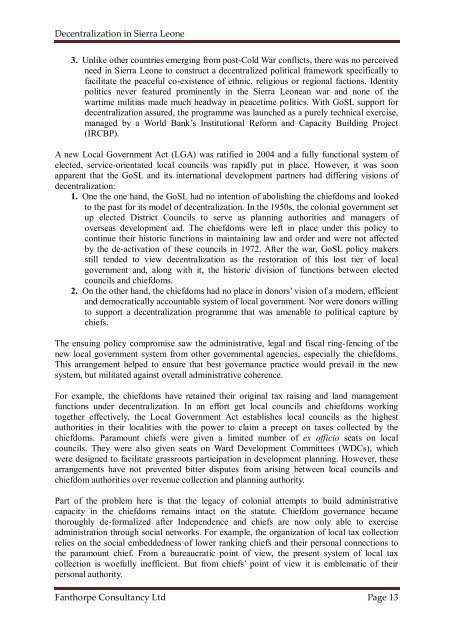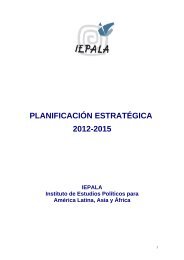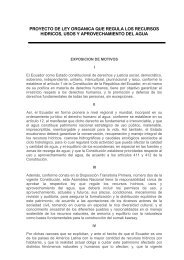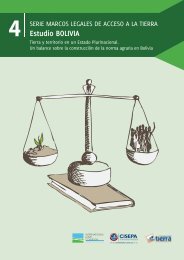Decentralization in Sierra Leone - Research for Development
Decentralization in Sierra Leone - Research for Development
Decentralization in Sierra Leone - Research for Development
Create successful ePaper yourself
Turn your PDF publications into a flip-book with our unique Google optimized e-Paper software.
<strong>Decentralization</strong> <strong>in</strong> <strong>Sierra</strong> <strong>Leone</strong>3. Unlike other countries emerg<strong>in</strong>g from post-Cold War conflicts, there was no perceivedneed <strong>in</strong> <strong>Sierra</strong> <strong>Leone</strong> to construct a decentralized political framework specifically tofacilitate the peaceful co-existence of ethnic, religious or regional factions. Identitypolitics never featured prom<strong>in</strong>ently <strong>in</strong> the <strong>Sierra</strong> <strong>Leone</strong>an war and none of thewartime militias made much headway <strong>in</strong> peacetime politics. With GoSL support <strong>for</strong>decentralization assured, the programme was launched as a purely technical exercise,managed by a World Bank’s Institutional Re<strong>for</strong>m and Capacity Build<strong>in</strong>g Project(IRCBP).A new Local Government Act (LGA) was ratified <strong>in</strong> 2004 and a fully functional system ofelected, service-orientated local councils was rapidly put <strong>in</strong> place. However, it was soonapparent that the GoSL and its <strong>in</strong>ternational development partners had differ<strong>in</strong>g visions ofdecentralization:1. One the one hand, the GoSL had no <strong>in</strong>tention of abolish<strong>in</strong>g the chiefdoms and lookedto the past <strong>for</strong> its model of decentralization. In the 1950s, the colonial government setup elected District Councils to serve as plann<strong>in</strong>g authorities and managers ofoverseas development aid. The chiefdoms were left <strong>in</strong> place under this policy tocont<strong>in</strong>ue their historic functions <strong>in</strong> ma<strong>in</strong>ta<strong>in</strong><strong>in</strong>g law and order and were not affectedby the de-activation of these councils <strong>in</strong> 1972. After the war, GoSL policy makersstill tended to view decentralization as the restoration of this lost tier of localgovernment and, along with it, the historic division of functions between electedcouncils and chiefdoms.2. On the other hand, the chiefdoms had no place <strong>in</strong> donors’ vision of a modern, efficientand democratically accountable system of local government. Nor were donors will<strong>in</strong>gto support a decentralization programme that was amenable to political capture bychiefs.The ensu<strong>in</strong>g policy compromise saw the adm<strong>in</strong>istrative, legal and fiscal r<strong>in</strong>g-fenc<strong>in</strong>g of thenew local government system from other governmental agencies, especially the chiefdoms.This arrangement helped to ensure that best governance practice would prevail <strong>in</strong> the newsystem, but militated aga<strong>in</strong>st overall adm<strong>in</strong>istrative coherence.For example, the chiefdoms have reta<strong>in</strong>ed their orig<strong>in</strong>al tax rais<strong>in</strong>g and land managementfunctions under decentralization. In an ef<strong>for</strong>t get local councils and chiefdoms work<strong>in</strong>gtogether effectively, the Local Government Act establishes local councils as the highestauthorities <strong>in</strong> their localities with the power to claim a precept on taxes collected by thechiefdoms. Paramount chiefs were given a limited number of ex officio seats on localcouncils. They were also given seats on Ward <strong>Development</strong> Committees (WDCs), whichwere designed to facilitate grassroots participation <strong>in</strong> development plann<strong>in</strong>g. However, thesearrangements have not prevented bitter disputes from aris<strong>in</strong>g between local councils andchiefdom authorities over revenue collection and plann<strong>in</strong>g authority.Part of the problem here is that the legacy of colonial attempts to build adm<strong>in</strong>istrativecapacity <strong>in</strong> the chiefdoms rema<strong>in</strong>s <strong>in</strong>tact on the statute. Chiefdom governance becamethoroughly de-<strong>for</strong>malized after Independence and chiefs are now only able to exerciseadm<strong>in</strong>istration through social networks. For example, the organization of local tax collectionrelies on the social embeddedness of lower rank<strong>in</strong>g chiefs and their personal connections tothe paramount chief. From a bureaucratic po<strong>in</strong>t of view, the present system of local taxcollection is woefully <strong>in</strong>efficient. But from chiefs’ po<strong>in</strong>t of view it is emblematic of theirpersonal authority.Fanthorpe Consultancy Ltd Page 13
















